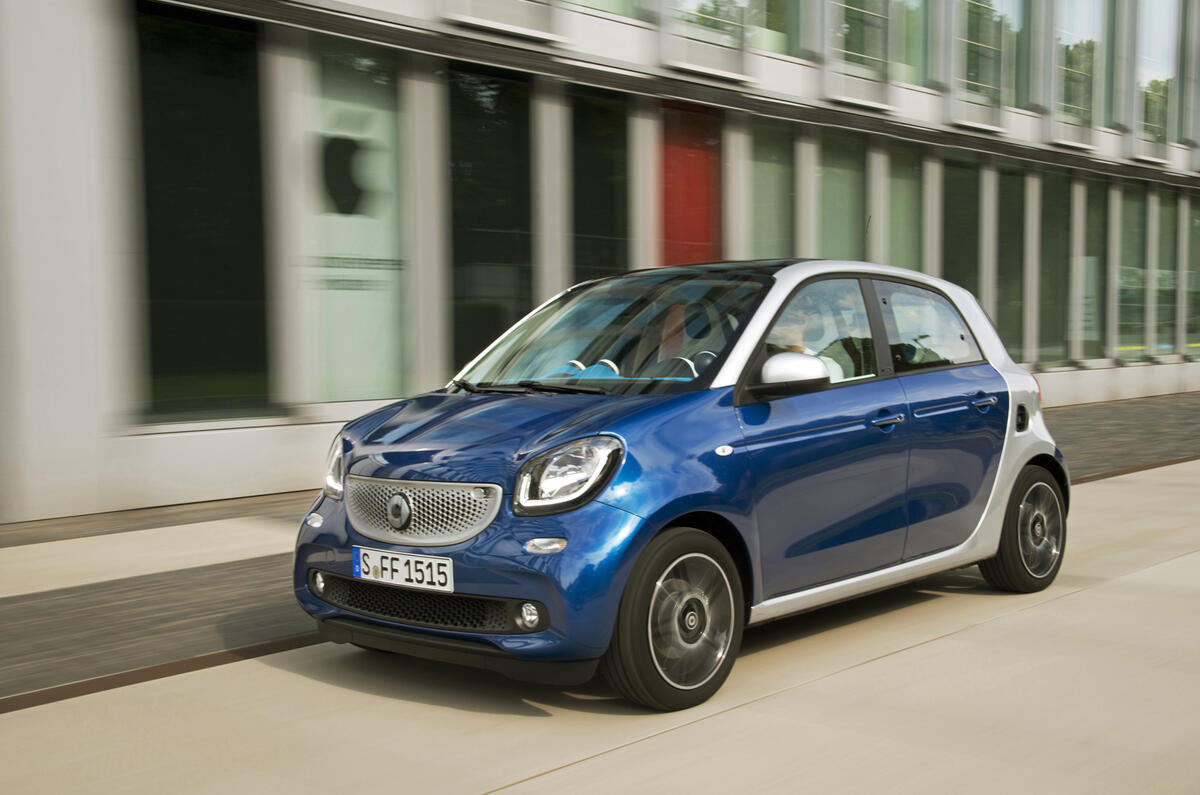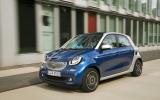What is it?
It's the all-new second-generation Smart Forfour, fitted with the firm's latest 'Twinamic' dual-clutch six-speed automatic gearbox and paired with the 0.9-litre turbocharged motor. It sits at the top of the Smart range.
We've sampled the Forfour previously on UK roads, but that version was propelled by a 70bhp 1.0-litre three-cylinder normally aspirated unit and mated to a five-speed manual gearbox.
As tested here in flagship Proxy trim, the Forfour is a generously equipped four-door city car. It gets two-tone leather upholstery, climate-controlled air conditioning, Bluetooth, USB connectivity, a panoramic roof, heated front seats, electric windows, lane-keeping assist, sports suspension and 16in alloy wheels all as standard. If you want your Forfour to swap cogs by itself you'll have to stump up an extra £995 for the privilege.
Smart's sport pack is offered as standard on the Proxy trim, though. It gains 16in alloy wheels painted in black, a leather multi-function steering wheel with mounted gearshift paddles (if the auto 'box is specified), suspension further lowered by 10mm, sports pedals and a chrome-plated tailpipe.
The Smart Forfour measures 3.5m-long, 1.6m-wide and 1.5m-high. To the eye, it doesn't appear that small, but the tape measure doesn't lie. It's still 4.5cm shorter and 3.5cm narrower than a Volkswagen Up. That combined with a remarkable turning circle of 8.65m compared with the Up's 9.8m means it should be almost comically agile in urban areas.
What's it like?
The Smart Forfour certainly makes light work of town driving. It has more than enough poke from the turbocharged 0.9-litre triple to pull out of junctions and get up to the speed limit swiftly.
Its new dual-clutch DCT auto 'box is a revelation compared with the horrendously jerky five-speed semi-automatic of the previous version. Upshifts are almost seamless in auto or manual mode and it's possible to double-tap the steering wheel-mounted gearshift paddles and make the Forfour drop two ratios in quick succession.
However, it's possible to confuse it; in auto mode and heading onto a motorway slip road, for example, plant your foot and the DCT will ponder whether to drop down a gear or not. For the most part it's a responsive transmission, though.
The 89bhp turbocharged motor also emits a pleasing, lively engine note which encourages you at every ideal opportunity to chase the 6000rpm redline. Although the engine delivers its 100lb ft of torque at 2500rpm, it's all out of puff by 5500rpm, meaning you have to make a concerted effort to keep the engine in this sweet spot in order to make decent progress.
Cracking 0-62mph in 11.9sec, it doesn't feel especially quick from standstill, but once up to speed, in-gear performance is decent for a city car; it's as quick around town as you'd ever realistically need a city car to be.
That said, motorways have to be tackled with the patience of a saint, as you're all too aware of the lack of power when pulling out into the fast lane to overtake slower traffic. Still, the Forfour was happy enough cruising at an indicated 75mph speed limit on a restricted German autobahn.
The Smart has well-weighted steering and a slightly quicker rack than expected. There's little body when pushing on, but the tyres cry for mercy too easily through twistier bends. Brake pedal feel is frustratingly vague, too.































Join the debate
Add your comment
It's the overtaking lane, not
90hp is perfectly adequate if you read the road ahead properly and use the right gear.
£15k
Some folk appear used to more powerful cars
We are too bhp greedy
Fair question. At least the word "glacial" didn't come in there, so the 70bhp one may be ok, it is everyone else that's the problem. I can tell you that 55bhp in a 12 year old Polo is not enough to accelerate from 60mph with any significance up a motorway incline, which is thrown sharply into focus if there is typically "pushy" traffic behind. I am no saint, but do not get impatient with it, even though more usually I have benefit of a swell of torque from a punchy TDi under my right foot. Just a little mental adjustment and extra anticipation is needed. Does seem rather expensive, but will the target market be too bothered? You do get a snazzy two tone colour scheme, such personalisation on other makes would be extra cost if available. The distracting reflections of the dash and air vents in the windscreen might bother me far more than any shortage of power.